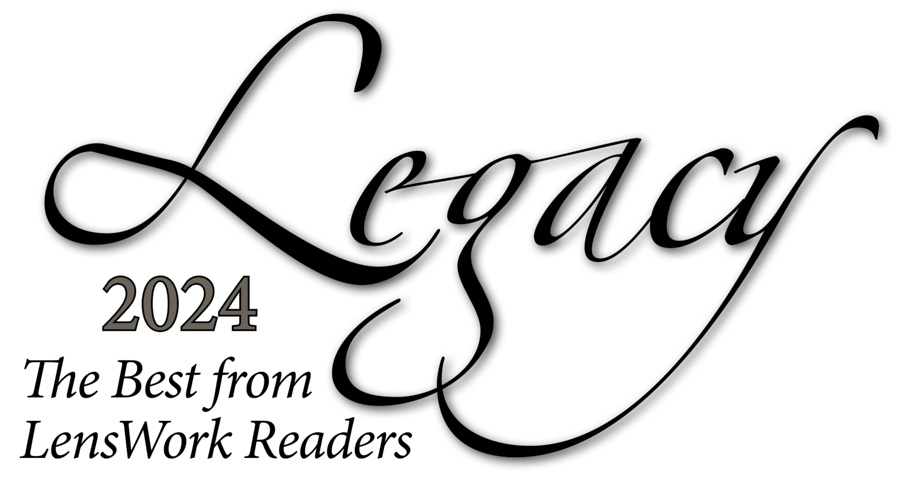
Anyone can enter! You do not need to be a subscriber or member.
Yes! Your choice! Keep in mind that this year we will be publishing three types of entries — single images, three-image trilogies, and 6-image Seeing in SIXES projects.
No, you can enter as many images/projects as you'd like. In fact, that will increase the odds of your work being selected for the final publication! Please note that each photographer selected for publication will only appear in the book once. We want to be sure we have as many photographers as possible in the finished book and PDF.
New this year! All subscribers to LensWork (print edition) will receive this book whether or not you enter. If you are not a subscriber to LensWork (print edition), you can still enter, and books will be available to you to purchase. We will have discount prices for pre-publication. Unlike in past years, you will not receive a book automatically — a change from previous years which has allowed us to lower the entry fee substantially.
No. Let's say you enter 3 single images and later decide you'd like to also enter a Seeing in SIXES project. You can do so — there is no limitation how many entries you may make. Each entry will require a $30 entry fee. Each entry will be reviewed individually regardless of how many entries you make. Each photographer can appear in the final publications only one time.
Sorry, but if we've already published an image we won't use it in Legacy 2024. We want to make room for new work!
Overseas entries are just fine. If you order books, there will be shipping options you can choose for your country.
Use the links in the Entry Form for uploading your images and paying the entry fees.
Unlike many other juried publications, you retain all copyrights to your images and written materials. LensWork Publishing is granted one-time only publication rights only for the printed book and the downloadable PDF.
No titles or text needed. Just images! We would, however, suggest that a title for a Seeing in SIXES project usually makes the project better.
JPGs saved at maximum quality are the smallest files to transmit, but we can also accept flattened PSD or flattened TIF files if you prefer.
We only need 8-bit files.
Adobe RGB (1998) is recommended for either color or b/w images. If you prefer, b/w images can be grayscale; we’ll convert all b/w images to our LensWork duotone in the prepress process. We'll convert all color images to our printer's CMYK press profile in the prepress process.
The PPI of the files you send to us is immaterial. We will adjust to the required PPI in our prepress workflow as we prepare your images for the printer. The only thing that really matters is that your images are at least 3400 pixels on the long side.
Yes. Each entry must be accompanied by this form.
Upload to us using the link in the Entry Form.
We can accept either b/w or color work.
Yes, for the b/w images.
To be fair to everyone, we will only review images as submitted. For example, enter the trilogy as a trilogy and then make a separate entry with the individual images you want. Also, it’s not fair for us to select from a trilogy or a sixes project the one image that you feel is a legacy image. Only you, as the artist, can make that determination.
Yes, captions are okay. Do keep in mind that the more text there is, the smaller the image will be in the final layout. Also, if you want us to include a caption, be sure to embed the text for the caption in the metadata of the file.
We are hoping to include:
There is no subject theme this year as we've done in the past. Instead, we are looking for your very best work — your Legacy images or projects. All work is acceptable for entry — whenever you photographed it! All subjects are acceptable, all formats, all treatments, all creative visions.
Craft is important, too. When images have the perfect tones, with a convincing depth of field, using the right lens, and the appropriate attention to details, it will be more persuasive than an image that appears sloppily crafted. Pay attention to edges and corners, distracting elements, and overly-processed images. It’s easy to overdo HDR, or color saturation and vibrance. Remember, techniques that are visible as techniques are probably too heavily applied.
Books can be ordered using this link. Order books
We will mail in late November or early December of 2024 as soon as it is off the press.
The book will be the same dimensions as LensWork but with lots more pages for additional content. Essentially, it will be a really thick issue of LensWork.
We debated about this for some time, but decided that we'd rather do a softbound with more pages (and thereby more photographers) than to spend the budget on the hardbound and restrict the page count so radically. So, softbound it is.
Email Brooks (editor@lenswork.com) and we'll do our best to answer any questions you have!